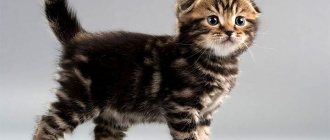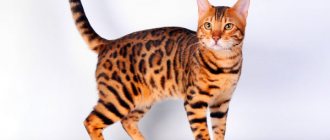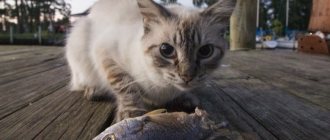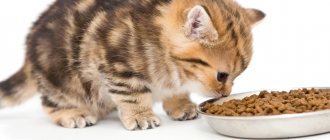British newborns, what they look like, photos
Outdoor cats choose dark, warm places to give birth, usually basements and attics. At home, you need to provide a “birther” for the British woman. It can be made from a large box, 60x60 cm in size, 40 - 50 cm high. Store banana boxes and exhibition tents are suitable. Lay out a diaper for animals and a heating pad.
Depending on the number of kittens in the cat’s womb, a newborn kitten can have a body length of 8 - 12 cm, the weight of kittens is from 70 - 120 g, there are small ones of 50 - 60 g, this happens when there is a multiple pregnancy. Weight table here.
The British are born blind, deaf, with large claws, without undercoat, the fur is not able to warm the baby, so you need to monitor the temperature of the “birthing place” ≈ 38 - 39 C⁰. At the age when kittens sleep 95% of the time, their innate sense of smell and touch allows them to find the cat's nursing nipple. The British mother licks the kittens; without her, they are unable to defecate. In the period from birth to 2 - 3 weeks, you should monitor the daily weight gain of babies by 10 - 20 grams, they should be weighed in the morning at the same time. If someone does not finish eating, then put it on the nipple more often.
Photo – British kittens 3 days old
Stages of development of a newborn British baby by day:
- Days 1 – 3 – baby sleeps, eats; how to determine the sex of newborn kittens is described in detail here
- 3 – 6 days – the umbilical cord heals, becomes black, dries out, and falls off;
6 days per photo
the picture shows that some already have an umbilical cord missing
- 4 – 7 days – hearing is formed, there is a reaction to loud sounds. The British are all straight-eared!
Plush kittens at 1 week
During this period, babies begin to crawl more actively, and many begin to open their eyes. Children's undercoat is formed and they react more actively to sounds.
British 7 days | 1 Week
It's time to increase the area for cats and choose a name.
British kittens in a playpen
Video of the British in 10 days below.
Little kitties 2 weeks old
British Shorthairs grow quickly, their weight has tripled since birth. They began to sleep less, eat less often, but the portions became larger. They begin to walk unsteadily, with long claws allowing them to maintain balance. By the end of the second week, the eyes open, they will immediately be a little cloudy. The first eye color is blue. They are seen a couple of days after opening on days 14–17. They hear the cat better and respond to its purring.
2 weeks
14 days
British 3 weeks
Kitties see and hear everything, sit and walk confidently, and try to jump. Baby teeth are visible. They are very curious and try to get out of their beds, so it is worth using fences and playpens. The area for children to play should be increased. Provide a scratching post, soft toys, a tray with filler and water.
The cubs actively play with each other, bite and hiss, and practice hunting skills.
2.5 weeks
3 weeks
Prohibited Products
Feeding British cats does not involve food from the human table. Many Britons have strange preferences: some love buns and chocolate, others prefer pickles and pickled peas. Under no circumstances should you indulge these whims and feed the animal regular food, this can lead to serious illnesses.
You cannot feed the British pork, or include egg whites, butter, river fish, any sweets, baked goods, as well as fried, smoked and pickled foods in the diet. Giving milk is also not recommended as it can cause diarrhea.
Cats of any breed should be fed only healthy food that has a beneficial effect on their health.
Kitten 1 month
The period of appearance of bear-type kittens. Month-old kittens are formed unevenly; a large body on short thick legs reminds us of a small bear. They sleep 16–20 hours, are very active, and play a lot.
4 weeks
Month-old kittens drink water on their own for 4 weeks, many eat wet and dry food themselves, and go to the litter box. Time to work with the kitten and adapt to the hands, teaching manners. The “change of color” of the eyes from blue to orange (for blue color), this happens gradually.
1 month
5 – 6 weeks | After 1.5 months, the kitten licks its fur and washes itself, the undercoat thickens, and the color becomes brighter.
5 weeks
At 7–8 weeks, babies are still drinking their mother’s milk and learning cat wisdom from her. The eyes acquired their color, became bright and clear.
1.5 months
What to feed
Food from the family table is not suitable for your pet. There is not much information on what to feed small British kittens. Contrary to popular belief, cats should not be fed fish 7 times a week. A photo of a British kitten by month shows the growth and external changes of the baby.
There are also age restrictions on the baby menu. What is the best way to feed a British kitten:
- lean boiled meats, exclude pork;
- cottage cheese, kefir and sour cream;
- boiled vegetables;
- cereals;
- boiled fish: no more than once a week.
What to feed 1st month
The kitten will be satisfied with its mother's milk for up to a month. At the beginning of the 4th week, the cat’s food dishes should be placed next to the cat’s bed. Babies will be attracted by the smell of food, then you can gradually introduce complementary foods: once a day. They give natural products or wet specialized food for kittens. The crumbs easily cope with food, bringing the food to 3-5 rubles per day. Growth and weight gain are monitored simultaneously: the kitten’s weight should correspond to the age norm. At 6 weeks the animal usually stops drinking cat milk.
What to feed 2nd month
At home, conditions of detention are not always followed, but you need to know what to feed a British kitten at 2 months. Babies at 2 months finally refuse mother's milk. Supplementary feeding is carried out up to 5-8 r. per day. Factory canned food is diluted with small portions of dry food
British kitten 2 – 3 months
Kittens feed themselves, go to the toilet, and play. They are very curious and it is worth taking care of their safety: close the windows, remove poisonous plants, dangerous sharp toys, threads, buttons. They suck a cat out of habit; they will do this until they are weaned or the cat stops letting them come to them. The paws of kittens lengthen and no longer resemble bear cubs, all this is due to uneven development. Character begins to emerge. It is worth spending more time raising children, teaching them to use a comb and a scratching post. Two months – it’s worth carrying out the first deworming and getting vaccinated; more about vaccinations here. Three months – repeated vaccination against viral infections and rabies vaccination are carried out. After three months, the kitten is considered socially adapted and can move to a new home.
Tray training
Usually, a kitten is taken from the nursery, which the cat has trained to use the tray, as an example. Breeders are also involved in education. But in a new place he may get confused. How to train a British kitten to use a litter box, steps:
- Show the litter box to the kitten.
- Pour in the litter and rustle in the tray with your hands, trying to interest your pet.
- Take your cat to the toilet after eating and sleeping.
- If the kitten manages to make a puddle, soak a napkin in the urine and put it in the tray.
Loose stools
Diarrhea in a kitten can be a sign of an allergy. In this case, contact with a possible allergen is excluded, antihistamine drops are given, or an injection is given in the clinic. It is important to determine why a British kitten has diarrhea and take action.
Food poisoning or infection can also cause diarrhea. In case of poisoning, do not feed for 1 day, give water and sorbent. If infection is suspected, exclude the possibility of plague.
Swallowing a piece of bag or string can cause loose stools. You need to monitor the animal: the object has not passed through the intestines, you need to take the baby for an ultrasound. A tick bite and the presence of worms also show a similar reaction in the kitten’s body. Give the anti-worm medication according to the instructions and the age of the baby. A tick bite, in addition to diarrhea, gives fever and shortness of breath: urgently need the help of a specialist.
Kitten 4 months – 1 year
Age 4 months – the number of meals is reduced, growth slows down, activity is high. Baby teeth begin to fall out.
5 months – the skeleton of the animal is formed, the pattern on solid colors practically disappears.
6 months – we see not a kitten, but an almost fully formed Briton. The coat needs weekly brushing. If the animal will not participate in breeding, then it is worth castrating or sterilizing it. 7 months – the male cat reaches sexual maturity. After 8 months, the British are considered adults. You should monitor your pet's diet.
12 months – gradually transfer the cat to adult or sterilized food. Read more about cat nutrition here.
adult blue shorthair at 14 months
From the age of 10 months, the British can participate in exhibitions, open class. You should visit a veterinarian annually and adjust your vaccination schedule. The British breed is fully formed by 2 - 3 years. Reviews from owners indicate that after castration, kittens do not become less active than before. The main thing is the desire to care and play with your pet.
Breed Features
Having studied the characteristics of the breed, you will know in advance what problems you may encounter as the kitten grows up. The British Shorthair cat is one of the most popular breeds all over the world. All British cats are similar to each other: they have a gray color, bright orange pigmentation of the eyes and erect ears. Any “derivatives” of the breed, for example, kittens with drooping ears, tabby or merle coloring, are mixed breeds.
A purebred British Shorthair cat with breeding documents is a potentially healthy animal. Before selling, the breeder is required to examine kittens for genetic diseases. Kittens that have been identified as having health problems are subject to castration, which makes it possible to maintain the health of the breed as a whole.
Hereditary genetic diseases of the breed are not very common, and their occurrence is due to the large population. It is known that British Shorthair cats are prone to food allergies, skin problems of various etiologies and rapid weight gain. The above characteristics of the breed must be taken into account when preparing the diet.
Choosing a place and utensils for feeding
A British cat should have a separate place for eating. Important terms:
- safety;
- comfort;
- privacy;
- availability.
You should not feed your Briton in a hallway where people often walk, or in a room with a TV constantly on. Extraneous noise will distract the cat.
For your information. If there is already a pet in the apartment, it is better to feed the kitten separately at first. Otherwise, the older pet may take the food away from him.
British cats are best fed from deep stainless steel or ceramic bowls. The dish should be wide enough so that the mustache does not rest against the sides. After each feeding, the bowls are washed, and the area where the cat ate is wiped with a damp cloth. You can put oilcloth or a rubber mat there - this will greatly simplify cleaning.
Mixed feeding
Breeders and felinologists do not recommend feeding the British cats both natural food and industrial food. This is fraught with problems with digestion and urination. In addition, it will be difficult for an inexperienced owner to balance the diet and calculate its calorie content.
Sometimes a British cat can still be given different types of food, but this needs to be done at different feedings. For example, offer your pet dry kibble in the morning and meat in the evening. But it is not recommended to practice this method constantly.
SEE THE STAGES OF KITTEN DEVELOPMENT IN THE KITTEN GROWTH TABLE
Let's consider all stages of development of kittens from birth to one year, their characteristics of maturation and growth, features of care at each age.
A newborn kitten is born weighing 80-120 grams, the size of kittens at birth is body length about 9-12 cm.
Very rarely, but still there are cases of the birth of kittens 50-70g, they are small but active. This does not always serve as a signal that the kitten is sick or has abnormalities. This also occurs in multiple pregnancies or in the case of small parents.
Newborn kittens: photo of the litter Newborn kittens are absolutely helpless during this period, they are blind, deaf, and do not know how to regulate their temperature. Newborn kittens have no undercoat; the fur is thin, weak and does not warm at all.
Newborn British kittens Kittens do not know how to stand on their paws, their bones are very fragile, so babies require special care. At this time, sleep and kittens are almost inseparable concepts. Newborn kittens sleep almost constantly and eat a lot and often. Kittens need sleep for the further development of their nervous system. Newborn kittens also cannot defecate on their own; the mother cat licks their genitals and eats their feces. What is really well developed in newborn kittens is their sense of smell and touch; they easily find their mother’s nipples, fingering them with their paws, sucking and, thereby, stimulating further milk production.
Newborn kittens: photo of the litter During this period, it is better not to touch the kittens at all, just monitor their weight. Kittens should add it daily (about 10-20 grams per day), if the kitten is growing, then everything is in order.
Things to take care of:
- Set up a box for a cat (or organize a maternity house) with newborn kittens. It should be warm and dry there. The bedding should be changed (it is advisable to use white sheets to track the color of the mother cat’s discharge), because The cat will have postpartum discharge. Also, if necessary, you can put a heating pad.
- Cat food. It should be plentiful and balanced; food is a must for nursing cats. Food and water should be freely available, next to the nest box. It is also recommended to place a tray here.
Cats are by nature excellent mothers and may not leave the box for a whole week, so it is important that newborn kittens have enough milk. In the first days, the cat produces colostrum (very fatty, nutritious milk that has antibodies, thanks to which kittens develop lasting immunity).
If there are a lot of kittens, be sure to make sure that each newborn kitten gets its good portion.
The development of kittens after birth (the development of newborn kittens) is very active, so the first week can be planned out day by day.
KITTENS – DEVELOPMENT BY DAY:
1-2 days after birth, a newborn kitten only sucks milk and sleeps.
After 3-4 days, the kitten’s umbilical cord heals and falls off.
After 4-5 days , the kitten’s hearing begins to develop, and you can already observe how it begins to react to loud sounds.
HOW LONG DO KITTENS SLEEP? WHY DOES A KITTEN SLEEP ALL DAY?
If it seems to you that the kitten sleeps all the time, this is most likely normal, and there is no need to worry right away. In the first week, the kitten sleeps about 22 hours a day. Just weigh the kitten daily - this is the best indicator that everything is fine with the baby.
A newborn kitten sleeps up to 22 hours a day. How much a kitten should sleep, he decides for himself, however, if the kitten sleeps constantly and does not gain weight, first of all, pay attention to whether the kitten has enough free nipple (this happens more often if there are 5 or more kittens in a litter) , if the kitten is weak or the last born, apply it to the cat more often and do not let other kittens chase it away. If in this case the kitten behaves sluggishly and does not recover, contact your veterinarian. Kittens from birth to one month change greatly both in appearance and development, and it is important to pay close attention to this in each period. Newborn kittens in the photo, look in the pictures.
Health
Newborn British kittens gain good immunity by being close to their mother for a long time. Within two weeks, their first teeth appear. You need to make sure that there is no inflammation of the gums.
Before vaccination, deworming must be carried out 10 days. Adult animals need to be given deworming medicine once every 3 months, especially if they go outside.
Although the British kitten is in good health, once you decide to have a baby, be prepared to pay attention to warning signs. If the cat constantly meows, is lethargic, and does not eat anything, then something is bothering her, but you should not make a diagnosis yourself. A veterinarian is qualified to identify diseases and treatments.











